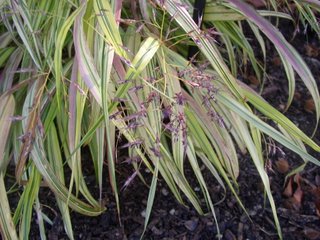
This year, I decided to do a little expirement with my 'Matrona' sedum. I don't particularly like the bloom on them--I fail to work pink into my garden very well--but I love the foliage.
I wondered if delaying bloom until a time when little else was flowering in the garden would make me like them more. Since I have two of them, I decided to let one grow without intervention and pinch back the other continually through the spring and early summer. The first picture shows the unpinched sedum, which is now beyond its disgustingly cheerful pink stage and into the dark pinky-brown shades that I much prefer.
 The second picture was also taken last week and shows the 'Matrona' that I pinched through early August. It's blooming right now, and I am happy to have something else blooming in the yard for the last of the bees to enjoy... so I guess that my experiment was a success in that regard. Instead of turning up my nose at the sedum, I smile as I check it for bees.
The second picture was also taken last week and shows the 'Matrona' that I pinched through early August. It's blooming right now, and I am happy to have something else blooming in the yard for the last of the bees to enjoy... so I guess that my experiment was a success in that regard. Instead of turning up my nose at the sedum, I smile as I check it for bees. The last picture shows why, bees or no, I will not be pinching my sedums quite so far into the summer this year... unless I move them. Their pink looks a little insipid against the fall colors of yellowing iris foliage. I was planning to keep this sedum here, but if I suppress its bloom until later in the season I risk having to look at a pink and yellow clash made all the worse by the rich fall colors around them. Yikes!
The last picture shows why, bees or no, I will not be pinching my sedums quite so far into the summer this year... unless I move them. Their pink looks a little insipid against the fall colors of yellowing iris foliage. I was planning to keep this sedum here, but if I suppress its bloom until later in the season I risk having to look at a pink and yellow clash made all the worse by the rich fall colors around them. Yikes!Maybe siting it nearer to a dark purple, burgundy or red foliage may suit the sedum's autumn show a little better. Near the oakleaf hydrangea? Closer to the doublefile viburnum? At this point in the season, I have several months to decide where its next "new home" will be... and that's good, because I tend to change my mind several times before giving anything a permanent home.
























